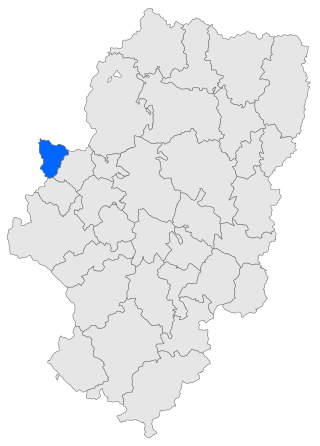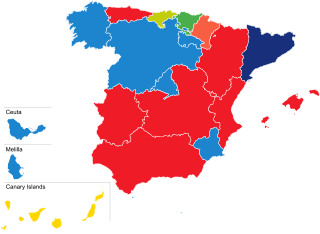Villafranca or Vilafranca may refer to:
Villafranca or Vilafranca may refer to:
Castile or Castille is a territory of imprecise limits located in Spain. The use of the concept of Castile relies on the assimilation of a 19th-century determinist geographical notion, that of Castile as Spain's centro mesetario with a long-gone historical entity of diachronically variable territorial extension.
Aguilar may refer to:

Soria is a municipality and a Spanish city, located on the Douro river in the east of the autonomous community of Castile and León and capital of the province of Soria. Its population is 38,881, 43.7% of the provincial population. The municipality has a surface area of 271,77 km2, with a density of 144.97 inhabitants/km2. Situated at about 1065 metres above sea level, Soria is the second highest provincial capital in Spain.
Torre means tower in seven Romance languages and may refer to:
Cuevas or Cueva may refer to:
Ribera is a Spanish word that translates into "the basin of a river", and may refer to:
Belmonte may refer to:

Both the perceived nationhood of Spain, and the perceived distinctions between different parts of its territory derive from historical, geographical, linguistic, economic, political, ethnic and social factors.
Spain has many coats of arms: the nation has one, the reigning monarch and the heir presumptive each have one, and there are others for the institutions of state and for Spanish regions and towns.
Fuentes may refer to:
Torralba can refer to:
Villar may refer to:
Cortes, Cortés, Cortês, Corts, or Cortès may refer to:

Tarazona y el Moncayo is a comarca in the Province of Zaragoza, within the Aragon region of northeastern Spain.

The 2007 Spanish regional elections were held on Sunday, 27 May 2007, to elect the regional parliaments of thirteen of the seventeen autonomous communities—Aragon, Asturias, the Balearic Islands, the Canary Islands, Cantabria, Castile and León, Castilla–La Mancha, Extremadura, La Rioja, Madrid, Murcia, Navarre and the Valencian Community—, not including Andalusia, the Basque Country, Catalonia and Galicia, which had separate electoral cycles. 812 of 1,206 seats in the regional parliaments were up for election, as well as the 50 seats in the regional assemblies of Ceuta and Melilla. The elections were held simultaneously with local elections all throughout Spain.

The 2011 Spanish regional elections were held on Sunday, 22 May 2011, to elect the regional parliaments of thirteen of the seventeen autonomous communities—Aragon, Asturias, the Balearic Islands, the Canary Islands, Cantabria, Castile and León, Castilla–La Mancha, Extremadura, La Rioja, Madrid, Murcia, Navarre and the Valencian Community—, not including Andalusia, the Basque Country, Catalonia and Galicia, which had separate electoral cycles. 824 of 1,218 seats in the regional parliaments were up for election, as well as the 50 seats in the regional assemblies of Ceuta and Melilla. The elections were held simultaneously with local elections all throughout Spain.

The 2015 Spanish regional elections were held on Sunday, 24 May 2015, to elect the regional parliaments of thirteen of the seventeen autonomous communities—Aragon, Asturias, the Balearic Islands, the Canary Islands, Cantabria, Castile and León, Castilla–La Mancha, Extremadura, La Rioja, Madrid, Murcia, Navarre and the Valencian Community—, not including Andalusia, the Basque Country, Catalonia and Galicia, which had separate electoral cycles. 804 of 1,198 seats in the regional parliaments were up for election, as well as the 50 seats in the regional assemblies of Ceuta and Melilla. The elections were held simultaneously with local elections all throughout Spain.

The Castilian House of Ivrea, also known as the House of Burgundy, is a cadet branch of the House of Ivrea descended from Raymond of Burgundy. Raymond married Urraca, the eldest legitimate daughter of Alfonso VI of León and Castile of the House of Jiménez. Two years after Raymond's death, Urraca succeeded her father and became queen of Castile and León; Urraca's and Raymond's offspring in the legitimate line ruled the kingdom from 1126 until the death of Peter of Castile in 1369, while their descendants in an illegitimate line, the House of Trastámara, would rule Castile and Aragón into the 16th century.

Regional elections were held in Spain in 2019 to elect the regional parliaments of thirteen of the seventeen autonomous communities—Aragon, Asturias, the Balearic Islands, the Canary Islands, Cantabria, Castile and León, Castilla–La Mancha, Extremadura, La Rioja, Madrid, Murcia, Navarre and the Valencian Community. 814 of 1,208 seats in the regional parliaments were up for election, as well as the 50 seats in the regional assemblies of Ceuta and Melilla. The elections were held simultaneously with local elections all throughout Spain, as well as the 2019 European Parliament election.
There is a variety of Vernacular languages spoken in Spain. Spanish, the official language in the entire country, is the predominant native language in almost all of the autonomous communities in Spain. Six of the seventeen autonomous communities in Spain have other co-official languages in addition to Spanish. Bilingualism in different degrees and in distinct communicative situations between Spanish and another language is a habitual practice for many of the Spanish people who reside in one of these autonomous communities.